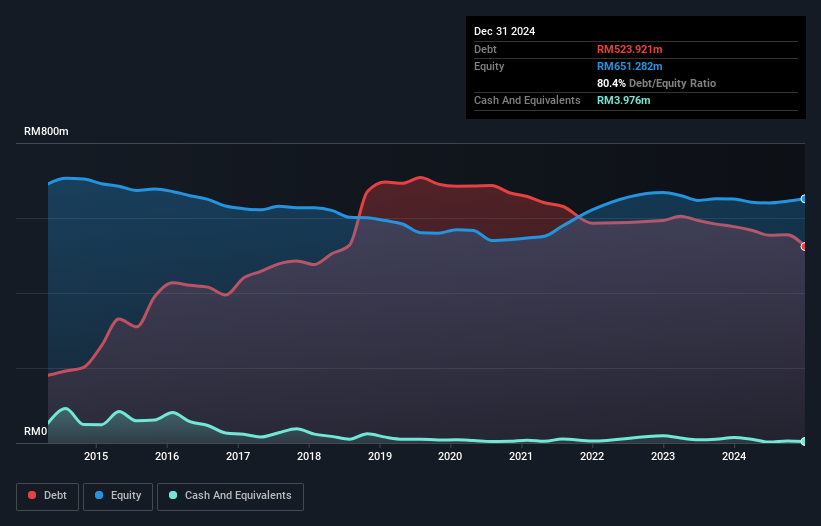- Malaysia
- /
- Paper and Forestry Products
- /
- KLSE:SUBUR
Here's Why Subur Tiasa Holdings Berhad (KLSE:SUBUR) Has A Meaningful Debt Burden

Howard Marks put it nicely when he said that, rather than worrying about share price volatility, 'The possibility of permanent loss is the risk I worry about... and every practical investor I know worries about.' When we think about how risky a company is, we always like to look at its use of debt, since debt overload can lead to ruin. Importantly, Subur Tiasa Holdings Berhad (KLSE:SUBUR) does carry debt. But the real question is whether this debt is making the company risky.
Our free stock report includes 2 warning signs investors should be aware of before investing in Subur Tiasa Holdings Berhad. Read for free now.When Is Debt A Problem?
Generally speaking, debt only becomes a real problem when a company can't easily pay it off, either by raising capital or with its own cash flow. Part and parcel of capitalism is the process of 'creative destruction' where failed businesses are mercilessly liquidated by their bankers. However, a more frequent (but still costly) occurrence is where a company must issue shares at bargain-basement prices, permanently diluting shareholders, just to shore up its balance sheet. Of course, plenty of companies use debt to fund growth, without any negative consequences. The first step when considering a company's debt levels is to consider its cash and debt together.
What Is Subur Tiasa Holdings Berhad's Debt?
The image below, which you can click on for greater detail, shows that Subur Tiasa Holdings Berhad had debt of RM523.9m at the end of December 2024, a reduction from RM577.0m over a year. Net debt is about the same, since the it doesn't have much cash.

How Healthy Is Subur Tiasa Holdings Berhad's Balance Sheet?
We can see from the most recent balance sheet that Subur Tiasa Holdings Berhad had liabilities of RM529.8m falling due within a year, and liabilities of RM293.5m due beyond that. Offsetting these obligations, it had cash of RM3.98m as well as receivables valued at RM56.2m due within 12 months. So its liabilities total RM763.1m more than the combination of its cash and short-term receivables.
The deficiency here weighs heavily on the RM131.9m company itself, as if a child were struggling under the weight of an enormous back-pack full of books, his sports gear, and a trumpet. So we definitely think shareholders need to watch this one closely. At the end of the day, Subur Tiasa Holdings Berhad would probably need a major re-capitalization if its creditors were to demand repayment.
Check out our latest analysis for Subur Tiasa Holdings Berhad
We measure a company's debt load relative to its earnings power by looking at its net debt divided by its earnings before interest, tax, depreciation, and amortization (EBITDA) and by calculating how easily its earnings before interest and tax (EBIT) cover its interest expense (interest cover). Thus we consider debt relative to earnings both with and without depreciation and amortization expenses.
Subur Tiasa Holdings Berhad shareholders face the double whammy of a high net debt to EBITDA ratio (6.1), and fairly weak interest coverage, since EBIT is just 0.98 times the interest expense. The debt burden here is substantial. One redeeming factor for Subur Tiasa Holdings Berhad is that it turned last year's EBIT loss into a gain of RM29m, over the last twelve months. The balance sheet is clearly the area to focus on when you are analysing debt. But it is Subur Tiasa Holdings Berhad's earnings that will influence how the balance sheet holds up in the future. So if you're keen to discover more about its earnings, it might be worth checking out this graph of its long term earnings trend.
Finally, a business needs free cash flow to pay off debt; accounting profits just don't cut it. So it's worth checking how much of the earnings before interest and tax (EBIT) is backed by free cash flow. Happily for any shareholders, Subur Tiasa Holdings Berhad actually produced more free cash flow than EBIT over the last year. That sort of strong cash generation warms our hearts like a puppy in a bumblebee suit.
Our View
On the face of it, Subur Tiasa Holdings Berhad's interest cover left us tentative about the stock, and its level of total liabilities was no more enticing than the one empty restaurant on the busiest night of the year. But at least it's pretty decent at converting EBIT to free cash flow; that's encouraging. Overall, it seems to us that Subur Tiasa Holdings Berhad's balance sheet is really quite a risk to the business. For this reason we're pretty cautious about the stock, and we think shareholders should keep a close eye on its liquidity. The balance sheet is clearly the area to focus on when you are analysing debt. However, not all investment risk resides within the balance sheet - far from it. For example Subur Tiasa Holdings Berhad has 2 warning signs (and 1 which is a bit unpleasant) we think you should know about.
If, after all that, you're more interested in a fast growing company with a rock-solid balance sheet, then check out our list of net cash growth stocks without delay.
New: Manage All Your Stock Portfolios in One Place
We've created the ultimate portfolio companion for stock investors, and it's free.
• Connect an unlimited number of Portfolios and see your total in one currency
• Be alerted to new Warning Signs or Risks via email or mobile
• Track the Fair Value of your stocks
Have feedback on this article? Concerned about the content? Get in touch with us directly. Alternatively, email editorial-team (at) simplywallst.com.
This article by Simply Wall St is general in nature. We provide commentary based on historical data and analyst forecasts only using an unbiased methodology and our articles are not intended to be financial advice. It does not constitute a recommendation to buy or sell any stock, and does not take account of your objectives, or your financial situation. We aim to bring you long-term focused analysis driven by fundamental data. Note that our analysis may not factor in the latest price-sensitive company announcements or qualitative material. Simply Wall St has no position in any stocks mentioned.
About KLSE:SUBUR
Subur Tiasa Holdings Berhad
An investment holding company, engages in the extraction and sale of logs in Malaysia, India, Japan, South Korea, Taiwan, and internationally.
Good value with acceptable track record.
Market Insights
Community Narratives




